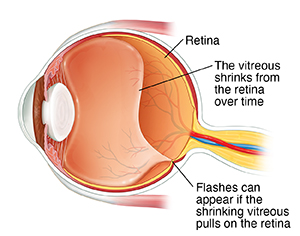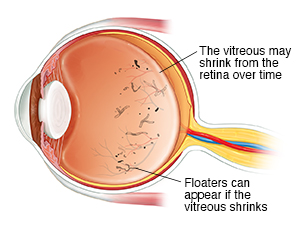Have you ever seen flashes of light, stars, or streaks that aren’t really there? A few of these flashes are seen by everyone from time to time. Usually you see them in one eye at a time. Flashes are often caused by the gel (vitreous) inside your eye pulling on the retina. The retina is a membrane that lines the inside of your eye.
Floaters look like dark specks, clouds, threads, or spiderwebs moving through your eyesight. Most people see them once in a while. Floaters may be pieces of gel or other material floating inside your eye. They are usually harmless.
Who gets flashes?
As you age or if you are nearsighted, you are more likely to see flashes. Nearsightedness is when you have fuzzy distance vision. Sometimes flashes are a sign of other eye problems that should be evaluated and may need care.
Who gets floaters?
The older you get, the more likely you’ll notice floaters. Floaters can also be caused by an eye injury or surgery. People who are very nearsighted may get more floaters. If floaters appear suddenly or greatly increase in number, see your healthcare provider as soon as possible. This may be a sign of an eye problem.



